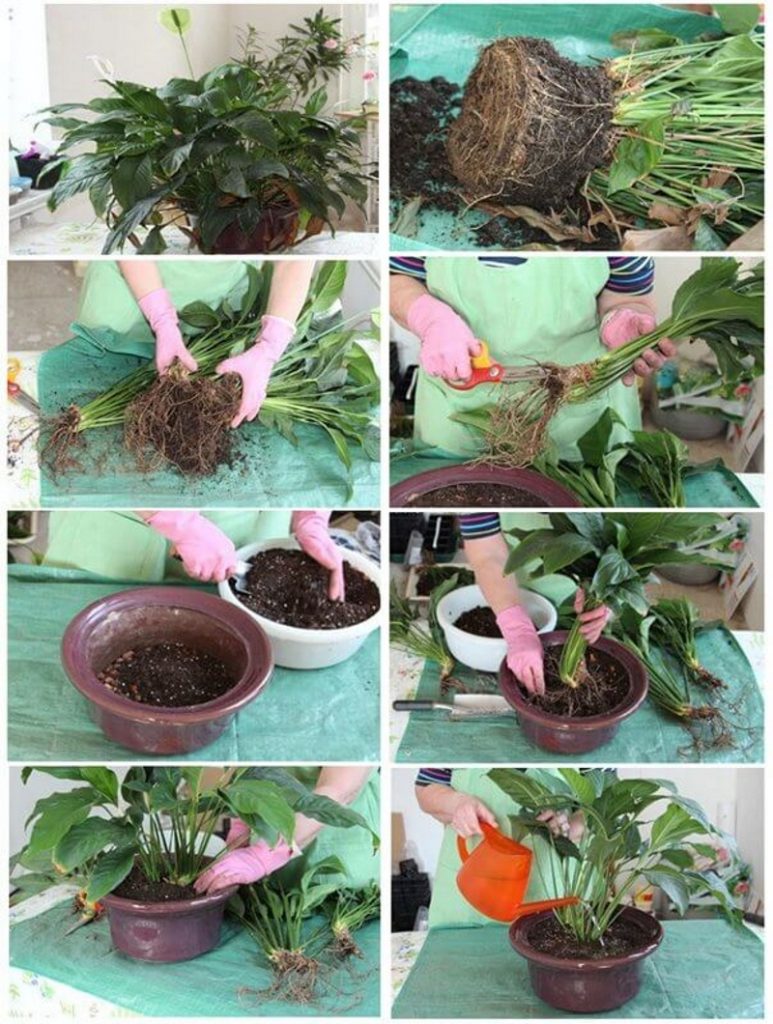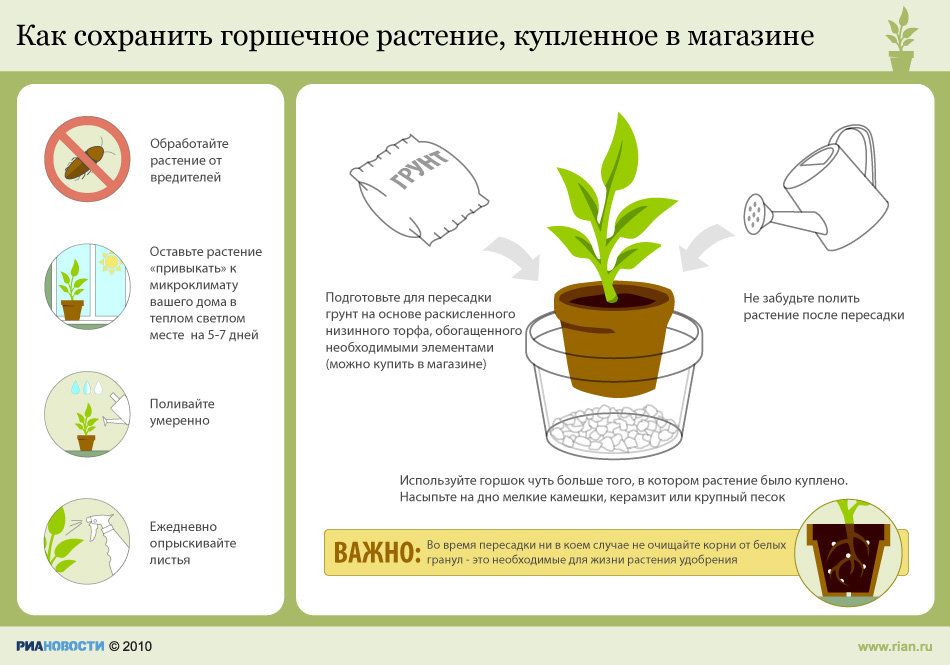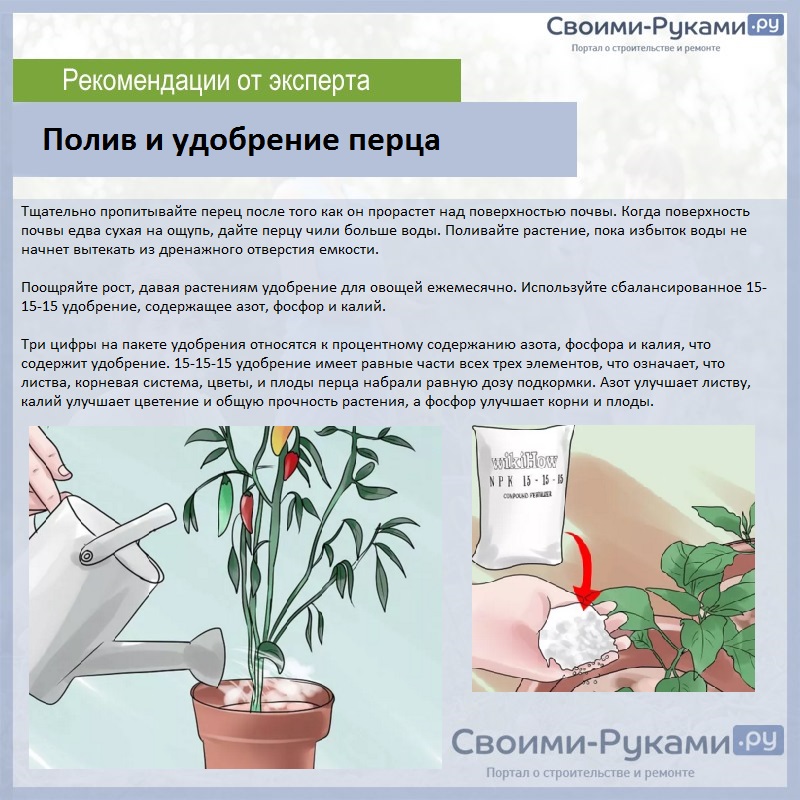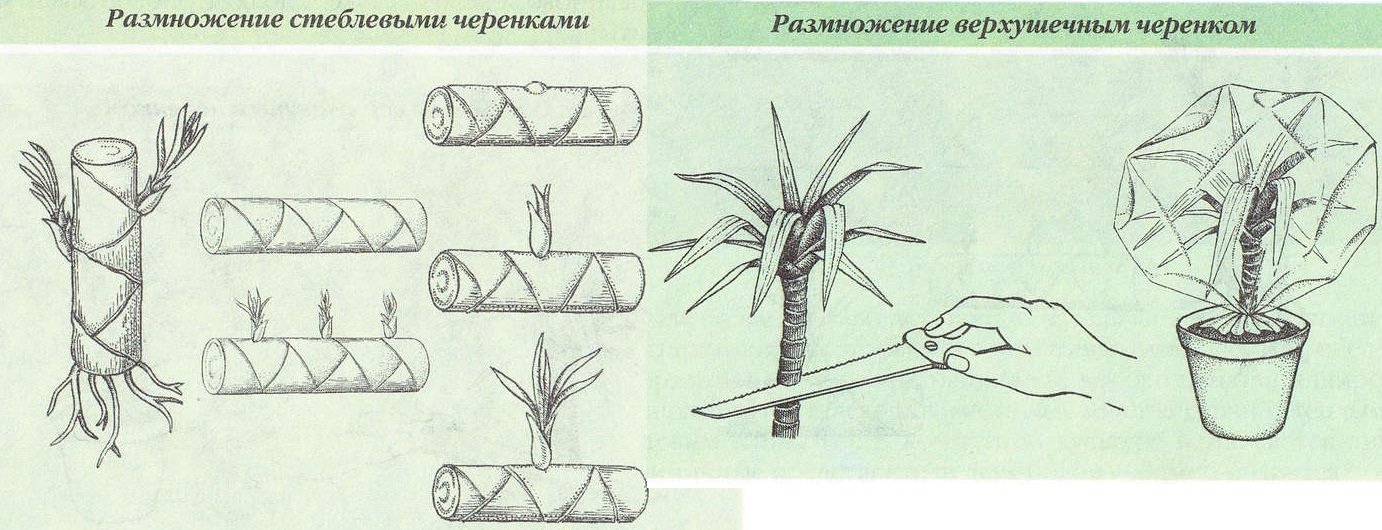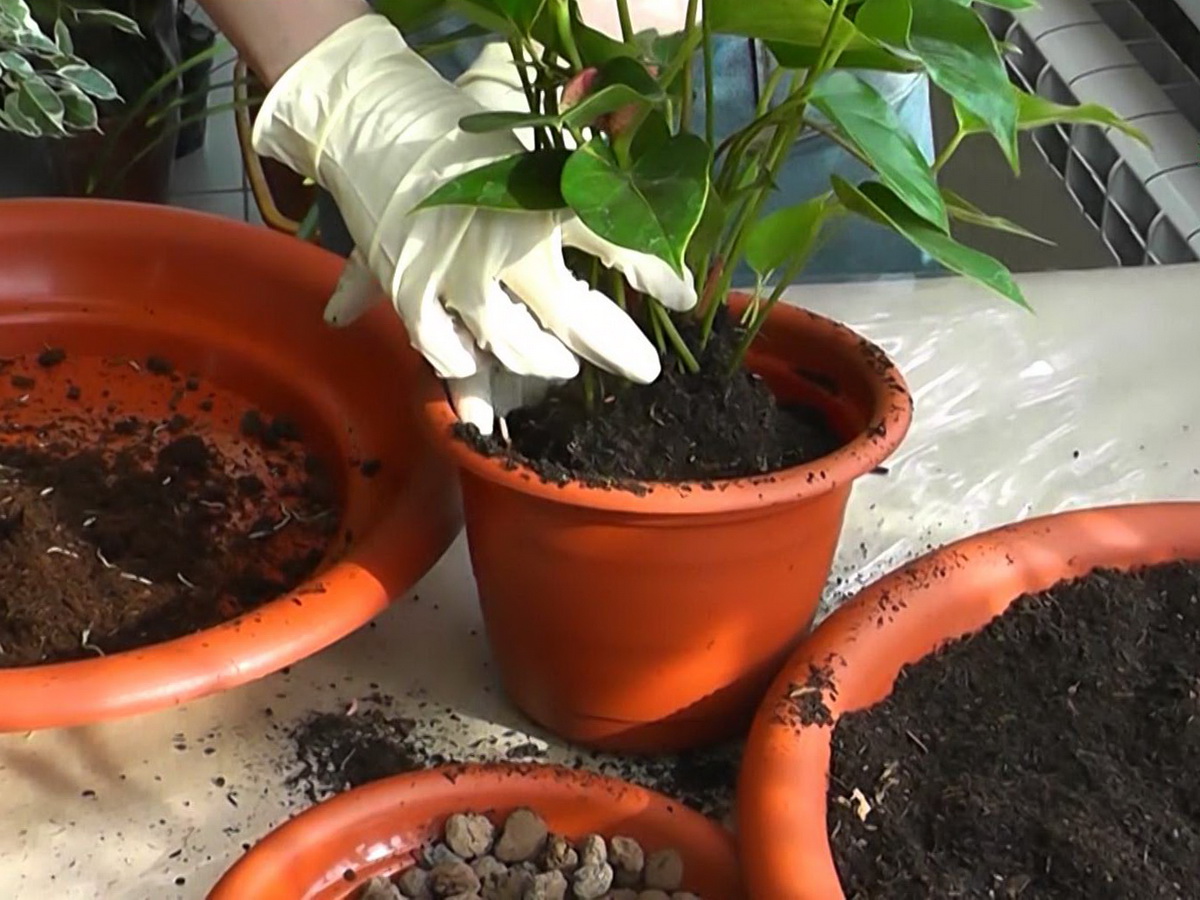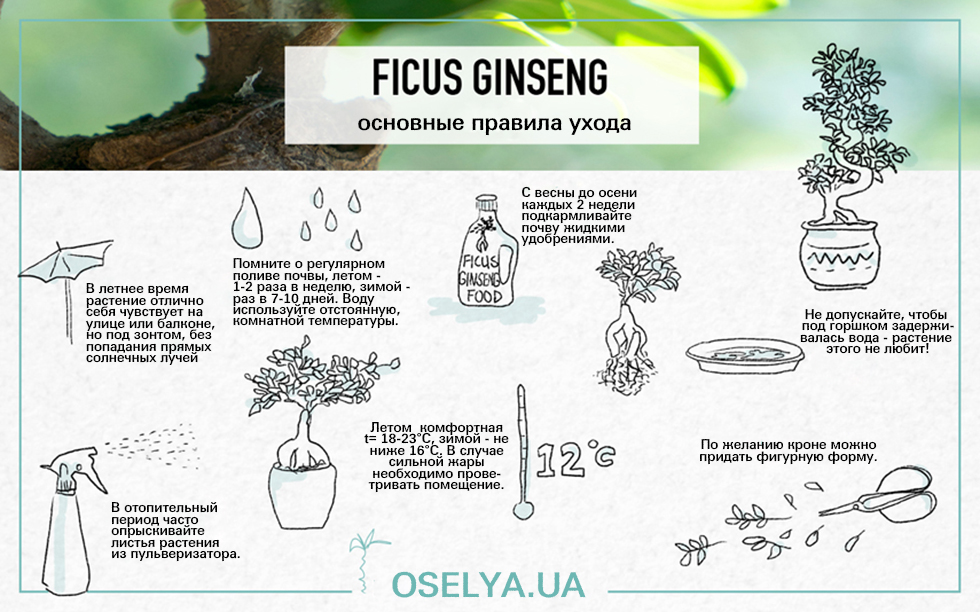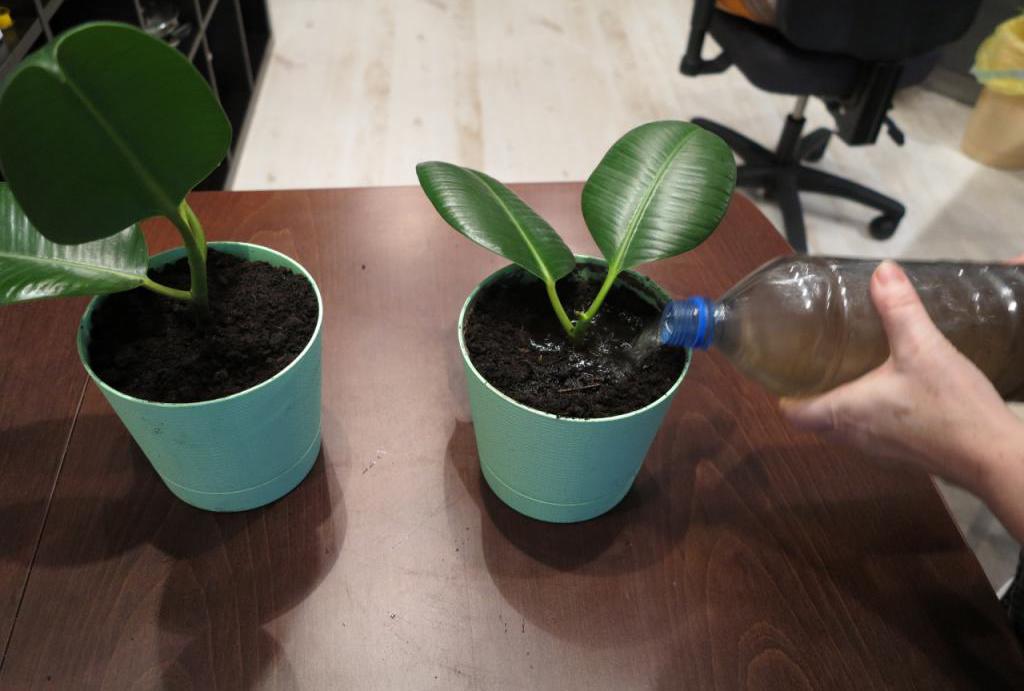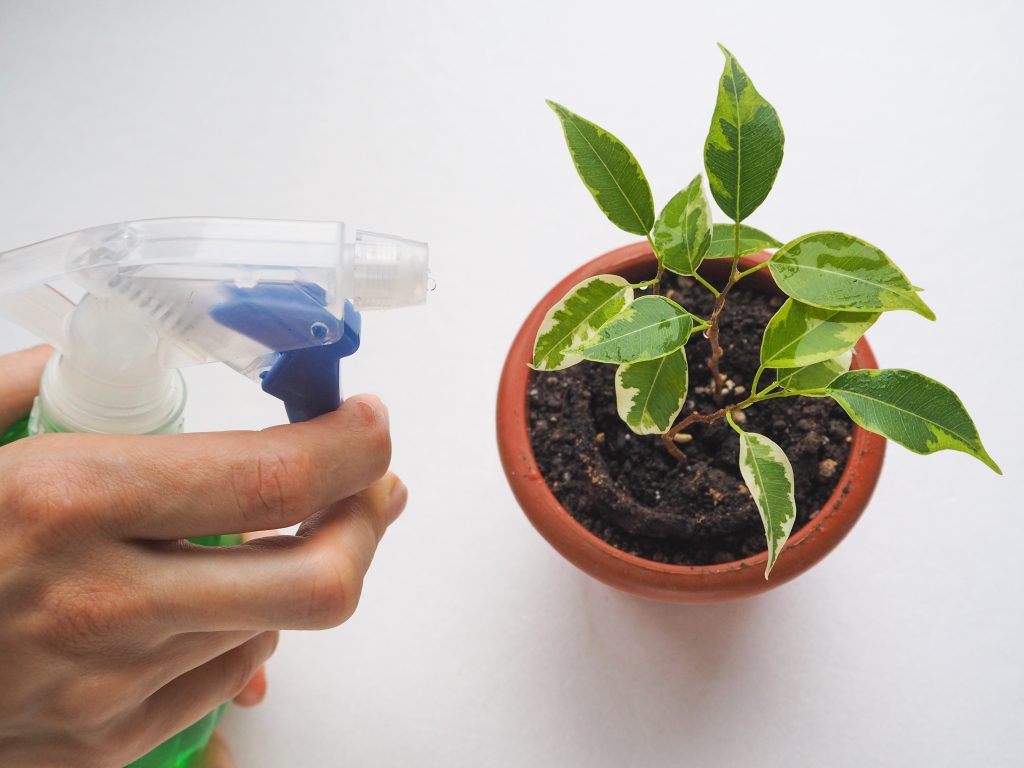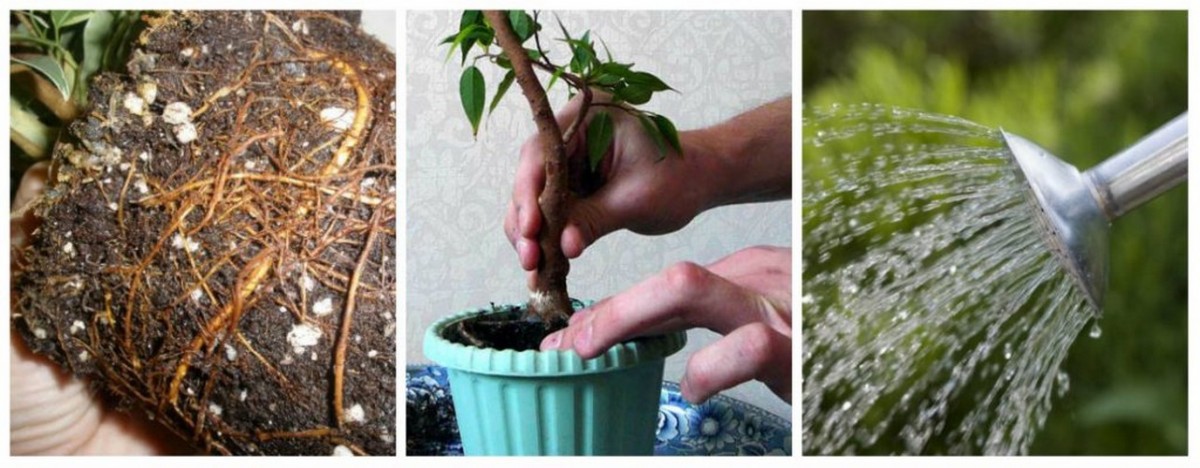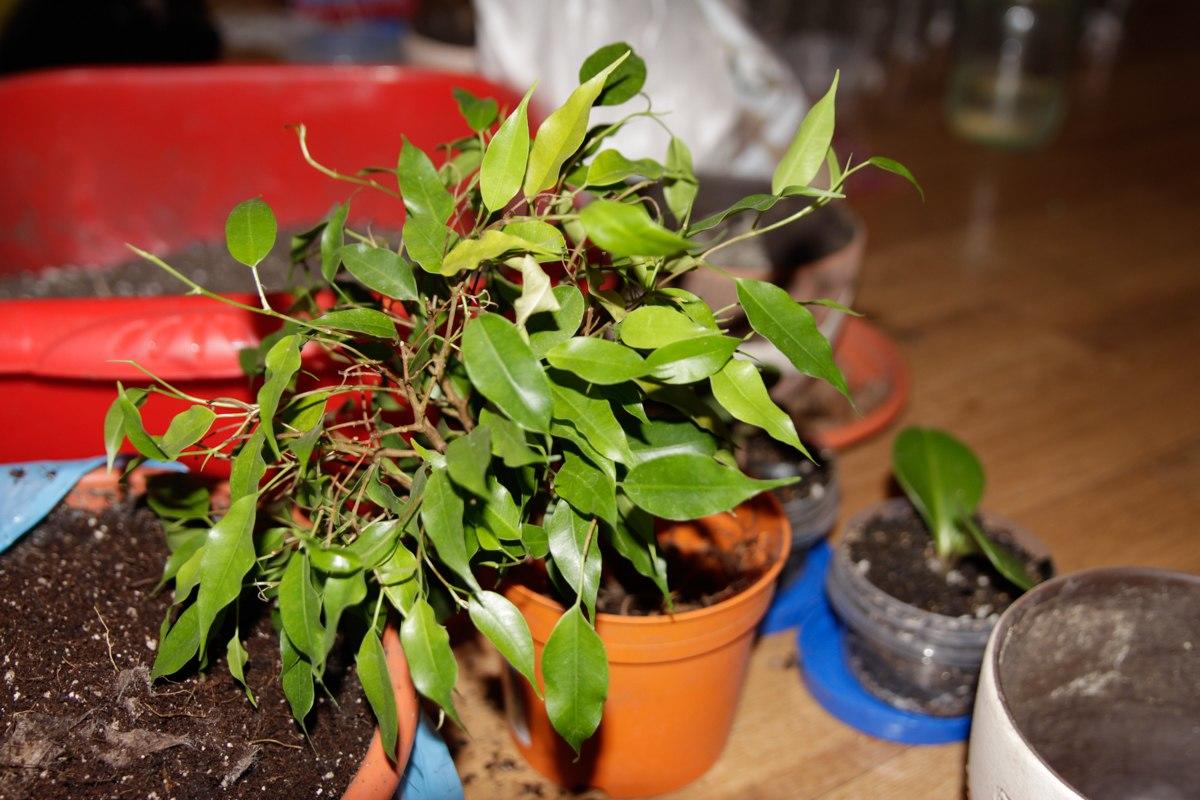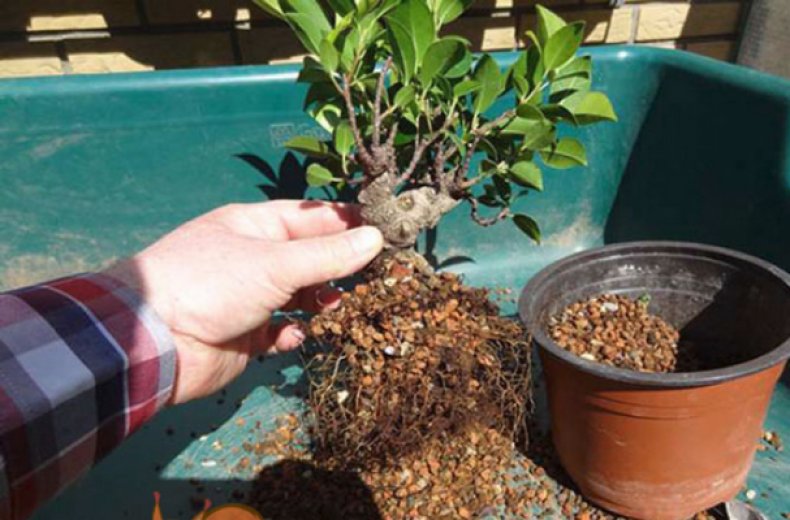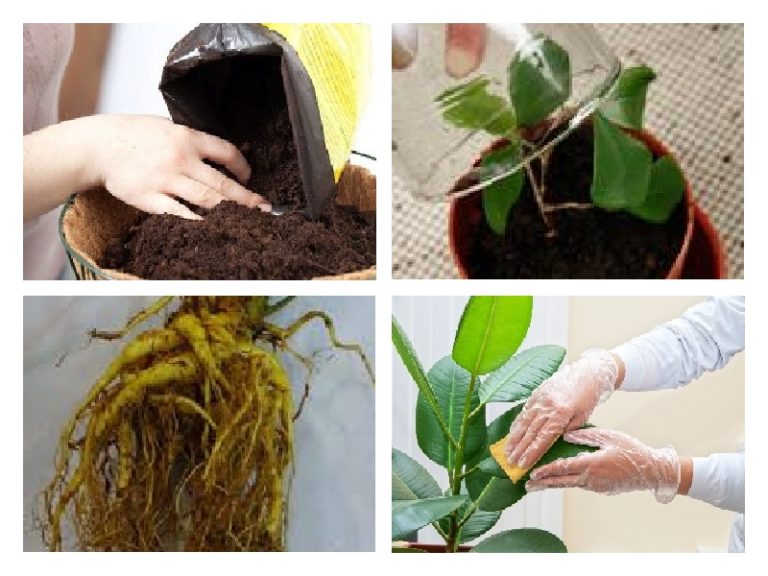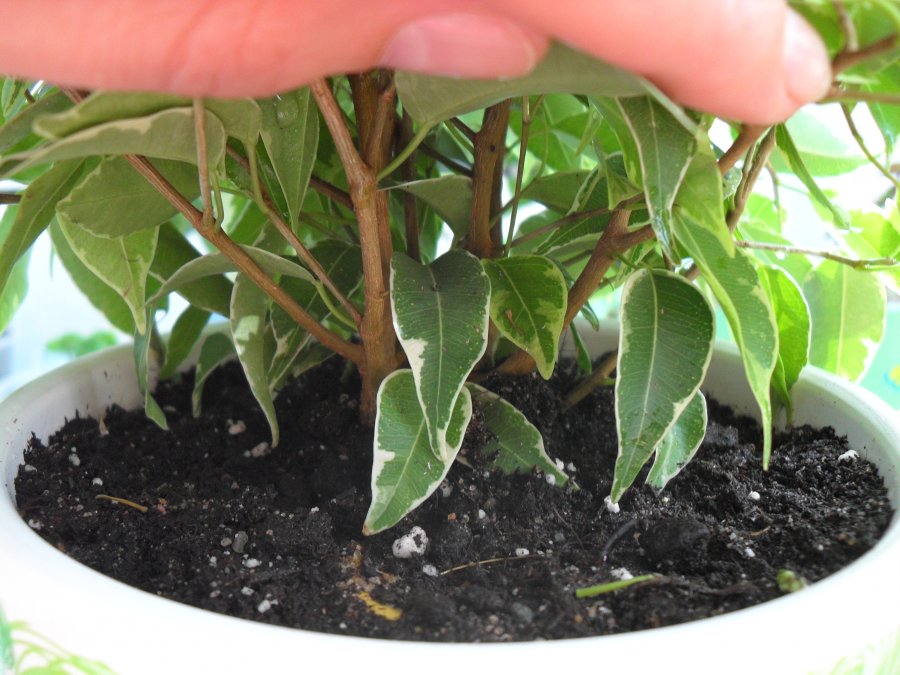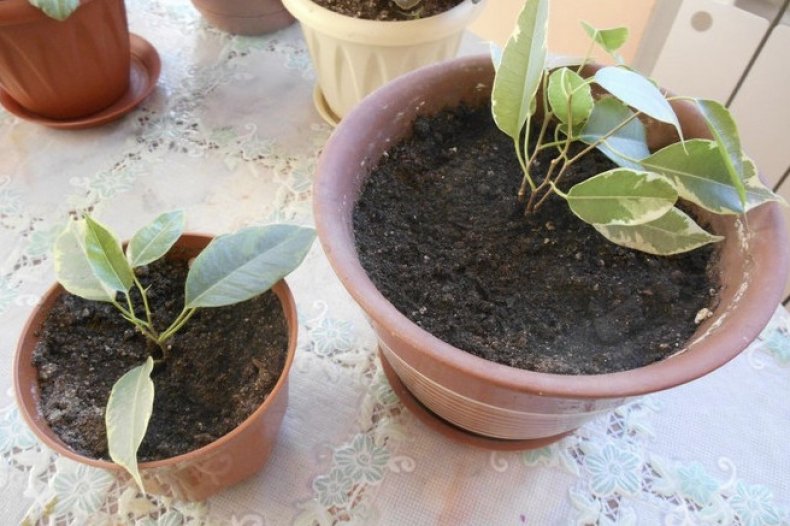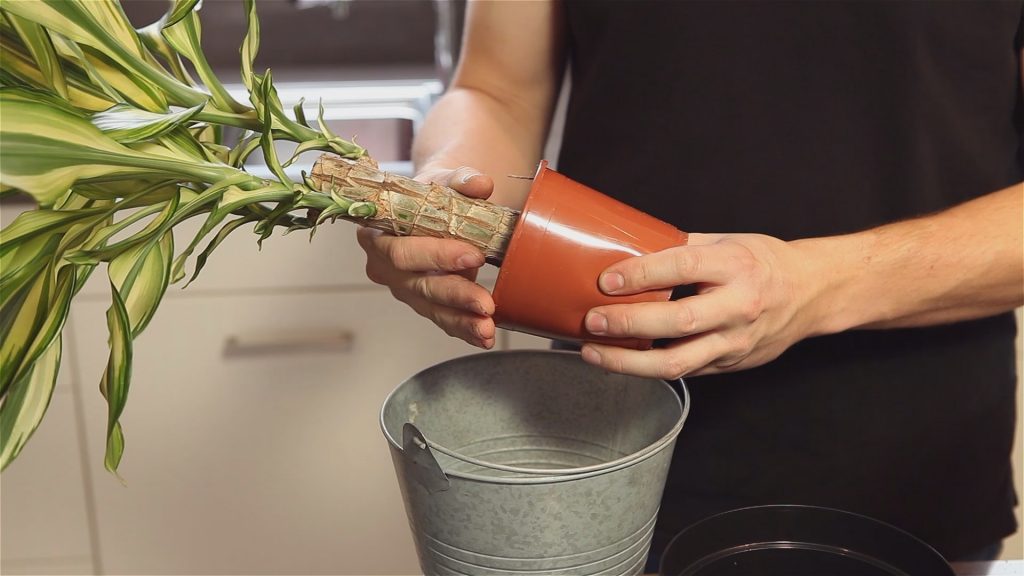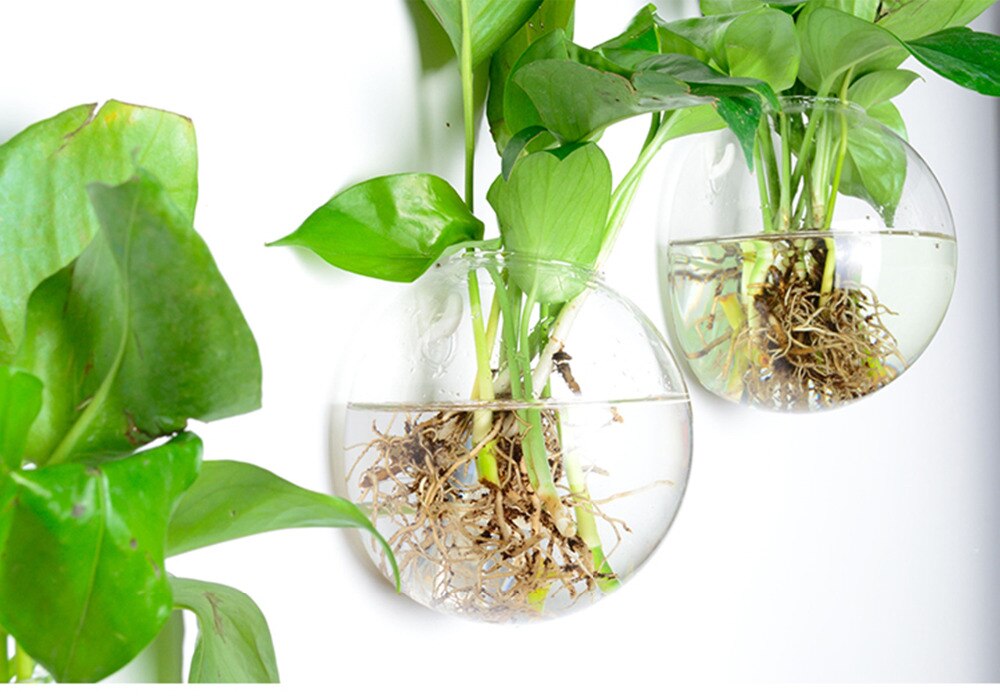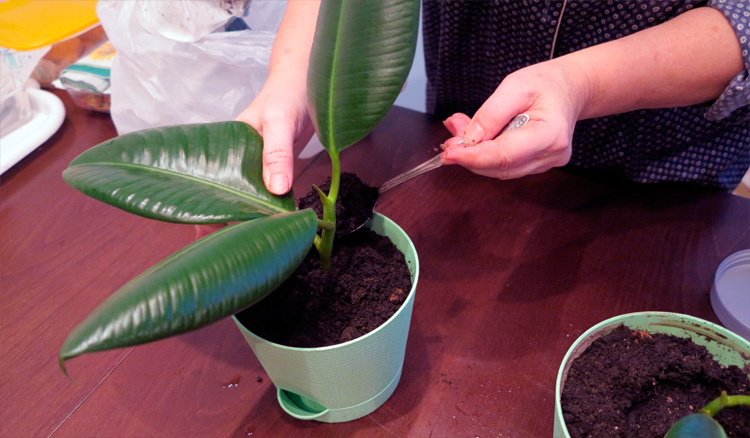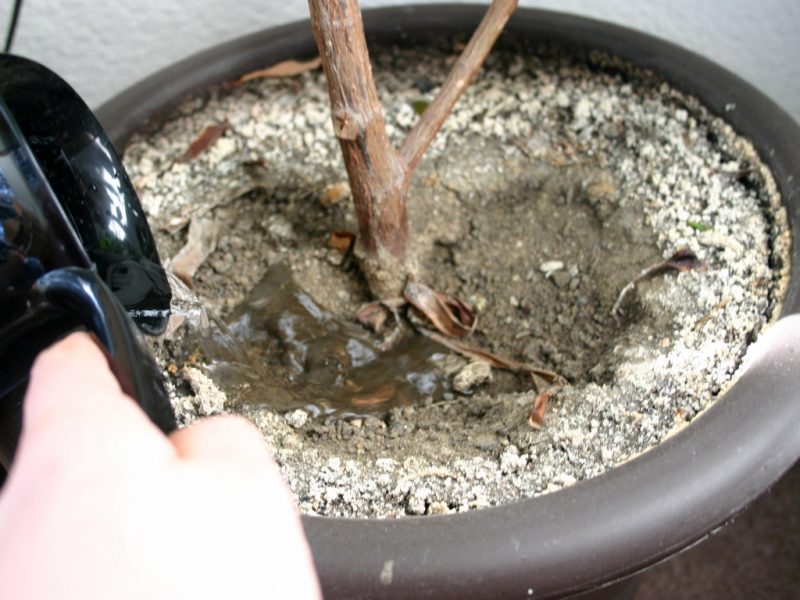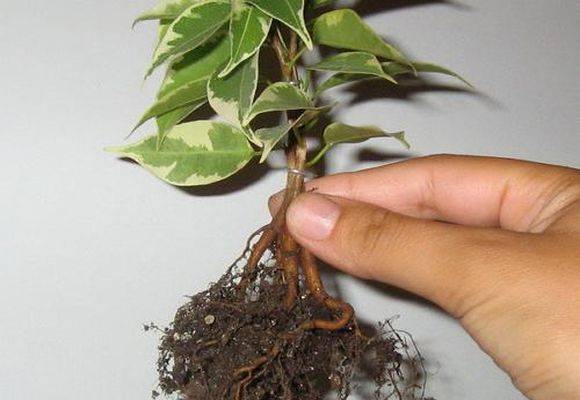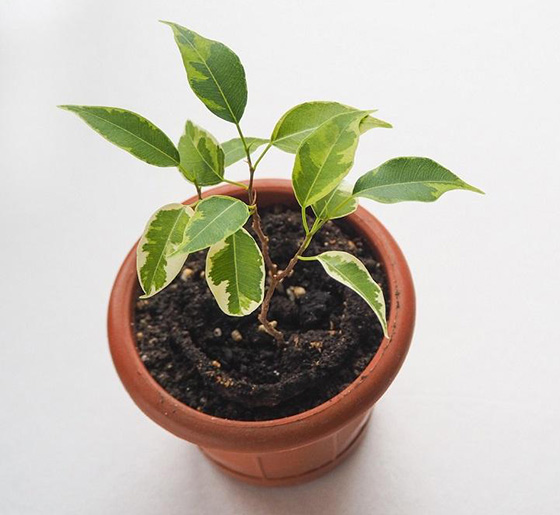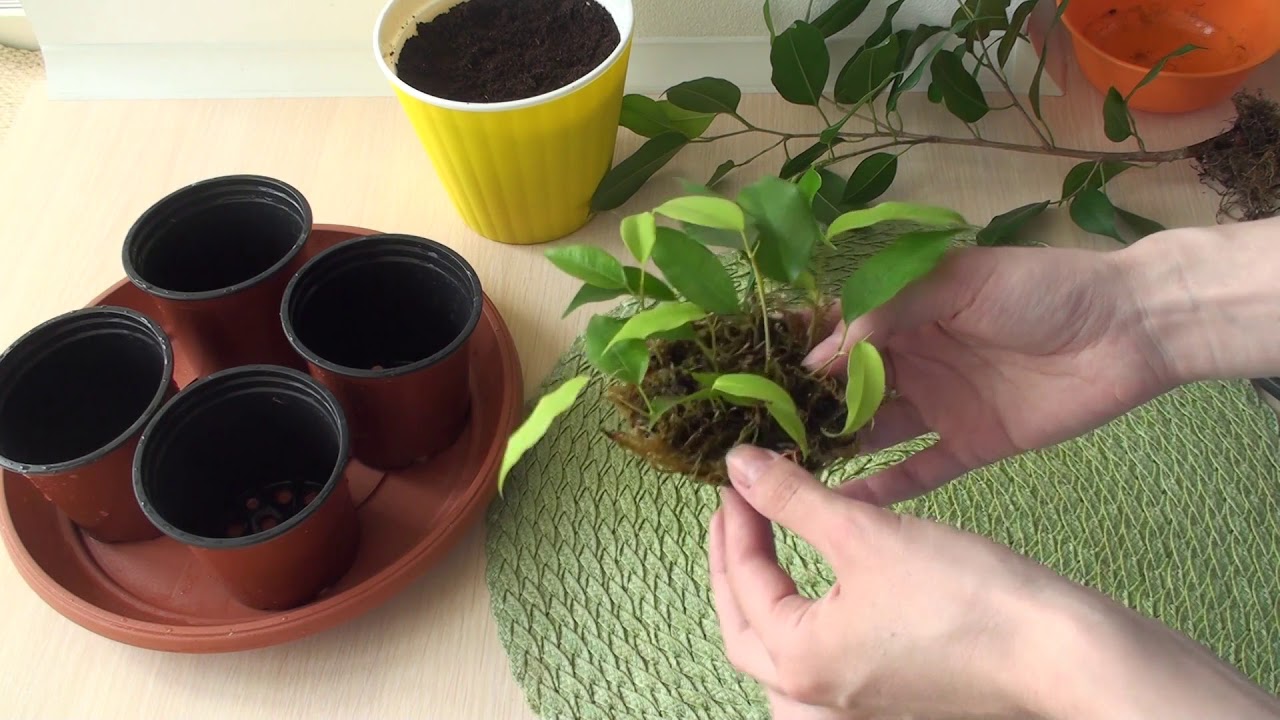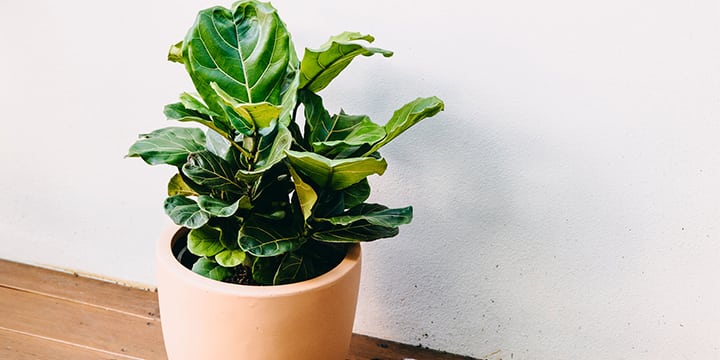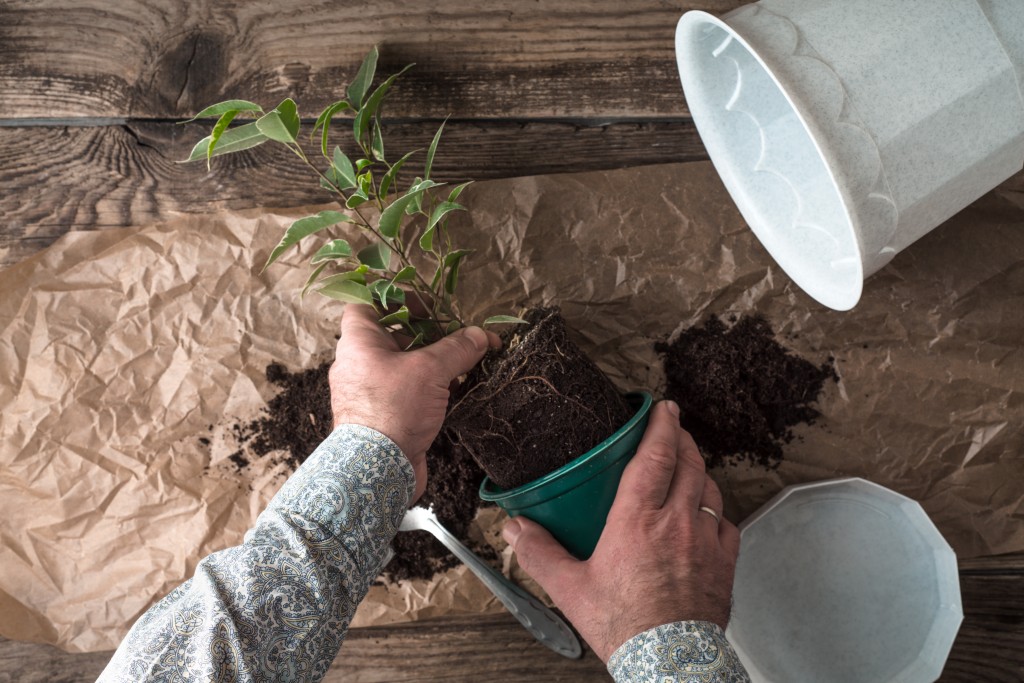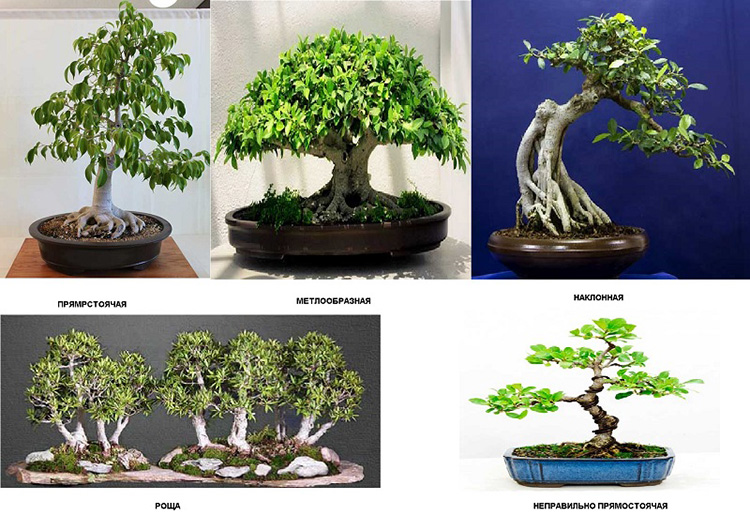How to transplant Benjamin's ficus: a detailed process for transplanting a ficus
Ficus transplantation improves the vital activity and productivity of the plant. Young plants need to be replanted annually, after reaching the age of four - once every 2 years. The main signs of the need for a transplant:
1
4


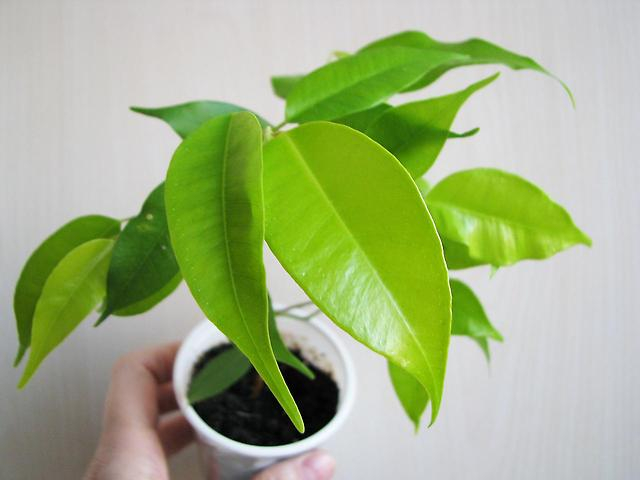

- the earth dries up quickly;
- the leaves turn yellow and the trunk is bare;
- the roots do not fit in the pot, stick out on the surface and emerge from the drainage hole.
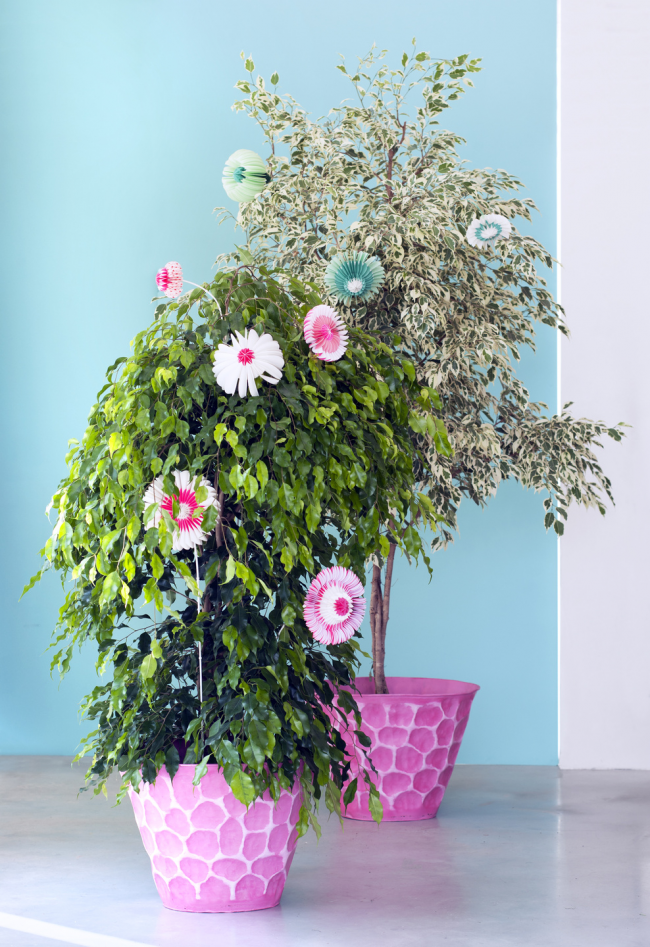
You can transplant a flower from a transport pot in 2-3 weeks, so it adapts better to the environment
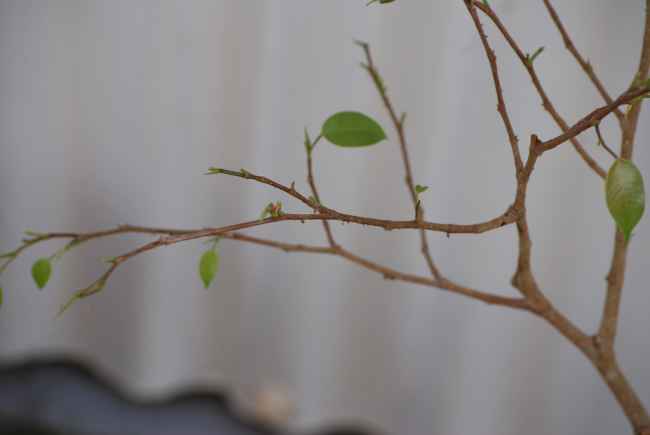
One of the reasons for the need to transplant Benjamin's ficus is leaf fall
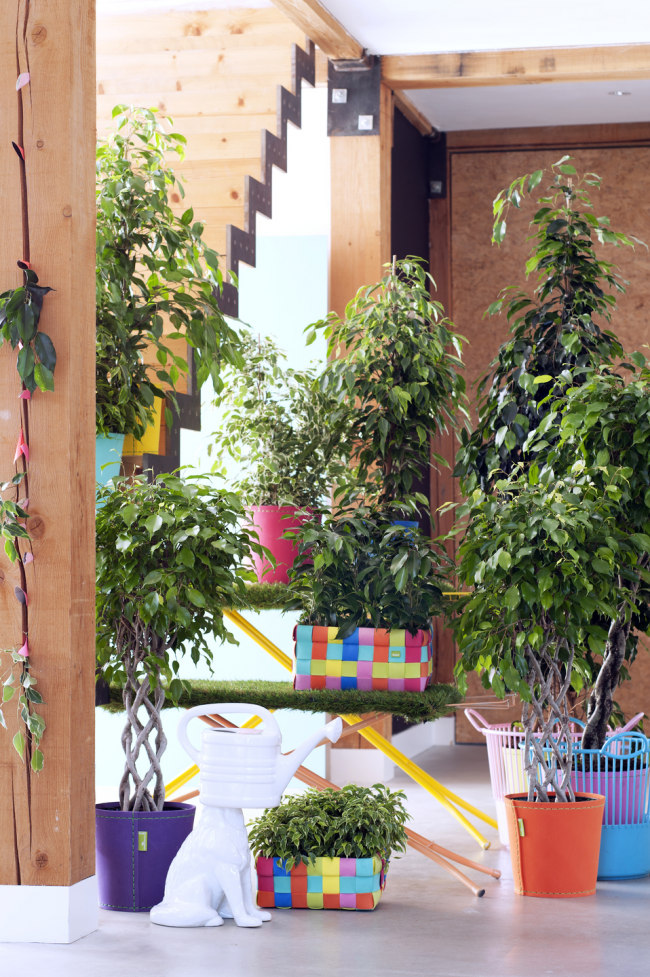
Original ficus arrangement in a spacious hall
How to transplant Benjamin ficus after purchase? In order for the plant to quickly and less painfully adapt to new conditions, the transplant is carried out exclusively in the spring-summer season. In this case, a new container for a plant is selected in diameter 3-4 cm wider than the previous one. It is not worth taking too wide a pot right away - and the ficus looks unaesthetic, and after transplanting it will grow more slowly: the wider the pot, the slower the roots grow. The root system should fit freely in the new container. For young plants, light soil is better - a mixture of equal shares of turf and leafy soil, to which one part of sand must be added.
1
4

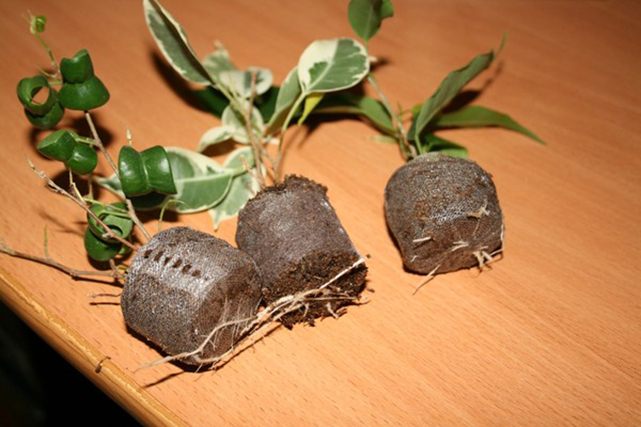


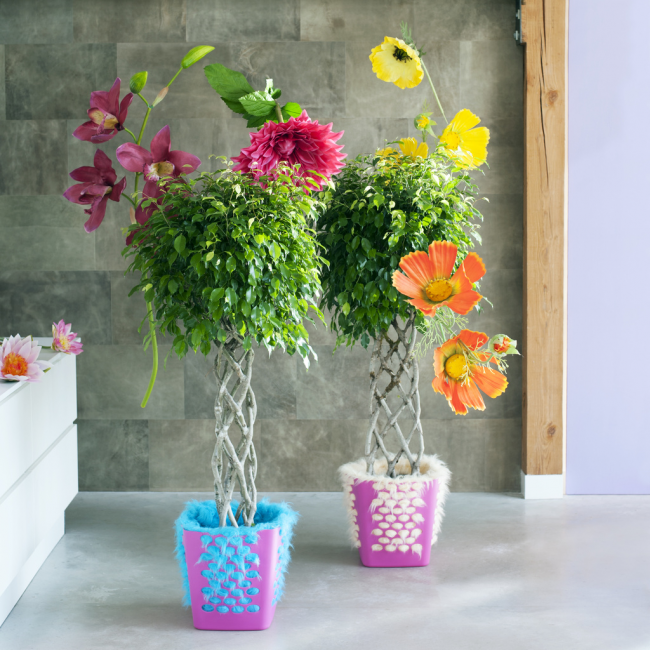
A beautiful bright small pot will help keep the ficus of the required height
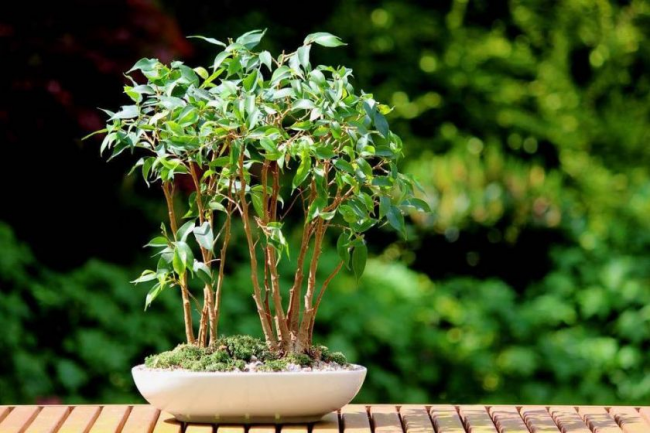
Ficus Benjamin is very popular as a houseplant, also grown in the bonsai style

Ficus is transplanted no earlier than two weeks from the date of purchase to give the plant time to adapt

Consider the sequence of Benjamin ficus transplant:
- before transplanting, the plant must be well watered - so it will be easier to remove it from the old pot;
- carefully remove the top layer of soil;
- put a drainage layer in a new pot and sprinkle it with earth;

When transplanting ficus, the roots are completely cleared of transport soil

The pot is taken according to the size of the root system - this makes it easier to adjust watering
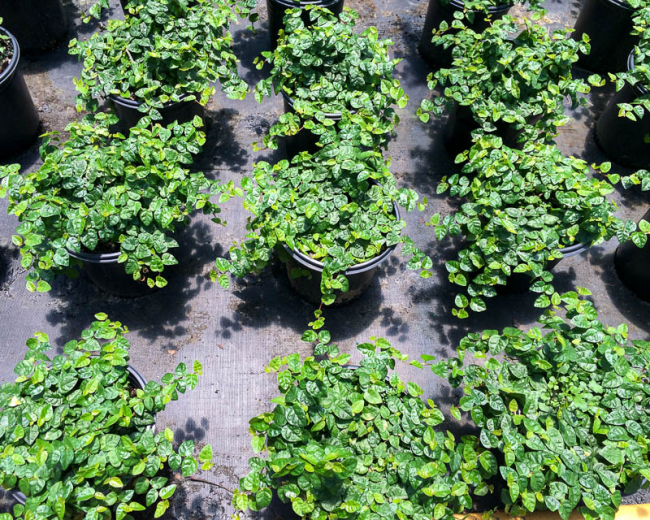
The soil must necessarily contain sand, and you can also add a little crushed charcoal
- remove the plant, gently shake off the soil from the roots and transfer it to a new pot;
- evenly add fresh soil on all sides, while observing the planting level - it should remain the same.
Crown formation, ficus pruning
Pruning is a popular method that allows you to shape Benjamin's ficus into the desired shape. Most often, the following types of crown formation are used for these plants:
- Spherical crown shape.
- Bushy.
- In the form of a single - or multi-tiered trunk.
- Bonsai style.
- In the form of various sculptures.
Experts recommend planning ficus pruning in the spring or early summer, since it is at this time of the year that its accelerated growth begins.
When forming the crown, it is necessary to take into account the age of the plant. The easiest way is to give the desired crown shape in young specimens. This, in turn, is a guarantee that, as a result of pruning, the plant will acquire the desired shape.
Pruning ficus Benjamin is usually considered in relation to those plants that have a fairly overgrown crown, or specimens that, due to their unusually large size, have lost their former attractiveness.
So that after pruning Benjamin's ficus not to face unpleasant consequences, it is necessary to carry out this operation, taking into account the following rules:
- try to make sure that after the operation the plant does not lose its naturalness;
- before removing branches, try to imagine how the ficus would look like without them;
- it is necessary to remove branches only with a sterile instrument;
- it is necessary to keep the bark intact;
- during pruning of ficus, care must be taken to ensure that the leaves are not damaged;
- ficus branches must be removed at an angle to the upper edge.
How to braid ficus trunks
 Crown formation is not the only method that allows the plant to return to its former attractiveness. Another method is table weaving.
Crown formation is not the only method that allows the plant to return to its former attractiveness. Another method is table weaving.
To do this, you will have to choose a couple of young specimens with a similar thickness and height of the tables, which are subsequently transplanted into a common pot.
Since in such plants the trunks become semi-lignified and at the same time retain their flexibility, they can be easily woven. Where the side shoots will connect, it is imperative to cut off all the leaves.
When creating the spiral and pigtails, you need to leave a lot of space, counting on the subsequent thickening of the trunks. A favorable time for the beginning of the plexus of the trunks occurs when the lower part of the flower grows to 13 cm.
Ficus Benjamin is one of the brightest representatives of the ficus family, which has retained all the best qualities of this indoor plant.
Growing it at home is a fairly simple exercise, however, and there are some points regarding care.
First of all, you need to pay attention to the fact that the plant must be periodically transplanted into a new container.
If it is important for the owner to maintain the decorative properties of Benjamin's ficus, then he will have to regularly prune the branches
Planting ficus in the ground
So how to plant a ficus plant in the soil?
Planting ficus should ideally be carried out in spring or summer, so you need to get rooted shoots in advance. It is desirable that this houseplant already have well-developed roots by autumn - this will help it to endure the winter more easily.
To grow Benjamin's ficus at home successfully, you first need to choose a suitable container. It must match the root system: Benjamin's young ficus will be best if the roots do not reach the walls of the pot in which they are planted by a couple of centimeters.
It is just as wrong to transplant ficuses into a too tight container, as it is to plant them in a pot that is too large: in this case, the water may stagnate during watering, which will cause the planted plant to rot. When planting, a layer of expanded clay or other drainage should be laid in a pot; they can be additionally covered with moss on top. The soil in which we plant rooted ficus should be rather loose, preferably sand, peat, vermiculite and perlite.
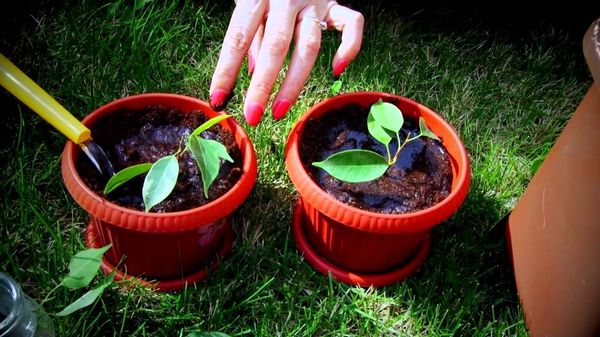
With a ficus that was rooted in the ground, and which you decided to transplant to a permanent place, you need to be especially careful not to damage the delicate roots. In principle, in this case, an urgent transplant of a plant rooted in the soil can be omitted and the ficus can be transplanted later, only when the roots become cramped. Such seedlings should be gradually weaned from the greenhouse, increasing the airing time, and, finally, begin to look after, as for an adult plant. They are transplanted shortly after rooting, most often in order to start forming a bonsai tree.
If you decide to grow a ficus with a shoot with aerial roots, you do not need to remove the moss from them.
How to properly plant a ficus shoot in prepared soil? Make a hole in the soil about one centimeter larger than the diameter and depth of the root system. Moisten the soil in advance and plant the cutting in the hole to the bottom leaf, then fill it up and tamp it slightly. It may be worth tying a peg to the ficus if it is unsure.
If you want to try growing a bonsai with intertwined stems, you can plant several plants in the pot. A ficus variety such as Microcarpa is well suited for this.
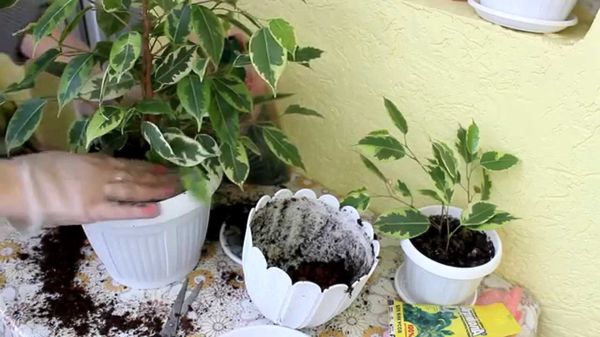
What kind of dishes to choose?
Material
It can be any, you just need to take into account the characteristics of each.
Clay containers absorb moisture well, which means they will protect the plant from accidental waterlogging. But this feature must be taken into account before landing.
To prevent an earthenware or ceramic pot from taking all the moisture from the soil, soak it in water for an hour.
Plastic does not absorb water. When choosing it, the height of the drainage layer at the bottom should be increased.
It is also recommended to lay a layer of peat or sphagnum on it - this will improve aeration of the roots.
For old ficuses, wooden tubs are suitable. Before use, they are fired from the inside to form a thin layer of charcoal.
It acts as a disinfectant, deacidifies the soil and protects the wood from decay.
The tubs should be made of oak or pine. Other types of wood quickly deteriorate, and you will have to replace it at the wrong time, which is not desirable for adult specimens.
The form
Standard pots with roughly equal heights and diameters will do.
Pans that are too high or too wide will not work - the soil that has not been reclaimed by the roots will acidify. For some species, large space is generally contraindicated.
The exceptions are bonsai-style ficus cultivation. For such specimens, flat and wide dishes are selected, with a height of no more than ten centimeters.
We recommend that you familiarize yourself with our other articles that will help you in successfully growing ficus and caring for the plant:
- How to propagate ficus at home?
- Why do the leaves turn yellow, turn black and fall? What to do in this case?
- What are the benefits and harms of ficus? Is it poisonous or not?
The size
The new pot is selected 3-4 centimeters wider than the previous one. When placing a plant in it, the gap between the roots and the edges should be about 3 centimeters - these are ideal conditions for the development of the root system.
In addition, the roots should be deepened in height by 2-3 centimeters from the drainage layer. That is, 5-6 cm from the bottom. In this case, the top layer of earth should not exceed 5 cm.
A wooden tub for transplanting an adult ficus is selected 6-7 cm wider and 8-10 cm higher.
Varietal variety
At home, many varieties of ficus are bred, having decorative foliage, adapted to the conditions of the room.
Decora
This species has wide, large foliage with a slight bend in the tip.
Advantages and disadvantages
rich green foliage;
impressive gloss on the leathery surface.
all defects on the sheet plates are noticeable.
The reddish central vein reaches the middle of the leaf.
I like not like
Doescheri
Ficus with narrow foliage and marbled gray-green or creamy green hue.
Advantages and disadvantages
exquisite color of foliage;
narrowed leaves.
demanding on lighting - the bush sheds foliage with a lack of sun;
in winter you need coolness.
A rare and highly decorative variety.
I like not like
Robusta
A handsome man with a rich green foliage - dense and fleshy.
Advantages and disadvantages
the easiest to grow, unpretentious;
removes harmful substances from the air.
to purify the air, you need to wash frequently.
Even a novice florist can grow Robusta.
I like not like
Black princ
Lovers of dark plants choose the Black Prince.
Advantages and disadvantages
rare, very dark foliage shade;
he spends the summer outdoors with pleasure.
with a lack of illumination, the growing season slows down.
The foliage is large, rounded.
I like not like
Variegata
Ficus with beautiful stains on the leaves.
Advantages and disadvantages
complex foliage color.
it is required to maintain illumination so as not to throw off the leaves.
Grows up to 2 meters.
I like not like
Trikolor
Variegated ficus, foliage combines cream, white and green tones.
Advantages and disadvantages
decorativeness.
with a lack of light, the foliage loses its tricolor;
loves warmth and sun.
Foliage patterning appears only with sufficient lighting.
I like not like
Tips for florists
- When transplanting a flower purchased at a flower shop, before placing it in a new pot, it is better to completely free it from the purchased substrate, which has fulfilled its role and can only harm the plant further. It is better to do this by rinsing the root part of the plant removed from the pot in warm water poured into a separate container, followed by rinsing under a stream of warm water.
- When a ficus grows into a tree that is too large, it is difficult to transfer or completely transplant it. Therefore, it is more expedient to replace the topsoil with a depth of 3 to 5 centimeters, necessarily adding a significant amount of organic matter to the new soil.
- It is necessary to water the domestic trees with settled soft water regularly in the summer, reducing it in the winter, when they have a rest time. In this case, be sure to take care not to flood the plant.
- Ficus leaves respond well to regular wetting, so it is good to wipe large leaves with a damp cloth twice a day in summer, and at least once a week in winter. Small-leaved specimens are always happy with a warm soul.
- Transplanting in autumn and winter is an unfavorable period for these plants. This procedure itself creates a stressful situation for them, requiring a lot of energy to adapt to new conditions. And in the fall, all processes inside the plant slow down, it prepares for the dormant period, when growth not only slows down, but also practically stops. The nutrients obtained in the summer, which were largely used up for adaptation during the autumn transplant, are not enough to successfully overwinter. Therefore, a transplant at this time is not recommended.
Features and rules for transplanting ficus
Ficus is considered an unpretentious plant that does not require complex care. But it is sensitive to drafts, excessive watering, cold water, and direct sunlight. But the main thing that the ficus does not like is transplants and changes in location.
These features should be taken into account, and the transplantation issue should be approached especially responsibly, observing certain rules:
- Young trees up to 3 years old require transplanting every year, plants from 4 to 6 years old should be transplanted in a year, grown ficuses - only once every 5 to 6 years;
- Before transplanting, the ficus must be watered in order to freely get it out of the previous pot;
- The new container should be 3-4 cm larger than the diameter of the old pot;
- It is better to carry out soil renewal in adults by transshipment, replacing the soil in part. This method helps not to damage the root part, since the earthen lump remains on its surface during transshipment, and partially fresh soil is added to the new pot.
Plant diseases
Most often, Benjamin's ficus is sick due to improper care.
- The appearance of yellow spots and tuberosity on the leaves indicates an excess of moisture in the soil.
- Leaves curl up and dry due to insufficient moisture.
- If the edges of the leaves turn yellow, it means that the plant does not have enough nitrogen.
What to do if the ficus begins to shed its foliage? First of all, check the condition of the plant roots. Remove rotten or dry areas, and lubricate the resulting sections with wood ash or activated carbon. Then transplant the ficus into a smaller pot and completely change the soil.
These plants also have specific diseases.
- Botrytis is characterized by the appearance of a white bloom on the foliage.
- Cercospora appears as dark blotches on the underside of leaves, causing them to wilt and crumble.
- Anthracnose is expressed in the appearance of brown spots and dryness of the edges of the leaves.
If you encounter such problems, cut off the damaged areas of the plant, treat it with an appropriate fungicide and leave it in quarantine for a while.
Now you know how to care for Benjamin's ficus. As you already understood, there is nothing too complicated in this, the main thing is to be attentive to the plant and provide it with comfortable conditions. And in return, it will delight you with its luxurious foliage.
How to properly care for a flower in an apartment
There are some differences in the features of caring for different varieties of ficus. Here are the basic rules that will ensure the rapid growth and decorative effect of the bush.
Pot selection and location
Basic rules for placing ficus:
- regular change of the pot with the growth of the bush;
- growing in a room of any orientation is allowed - on the north side they are placed on a windowsill, tulle and curtains are removed;
- on the sunny side, the ficus is shaded in the middle of the day;
- variegated species need sunlight for a significant part of the day.
Ficus does not tolerate drafts, slows down growth with frequent changes of place.
Temperature and illumination
Ficus grows well at moderate temperatures of 20-25 °, in winter it is better to reduce the indicator to 14-16 °. Scattered light rays are ideal for ficuses. During the hot sun (11-16 hours), the culture is shaded. Variegated varieties need sun.
Air humidity
If the pot is not located near a hot radiator, you do not need to spray the ficus. It is enough to regularly wipe the foliage with a damp sponge.
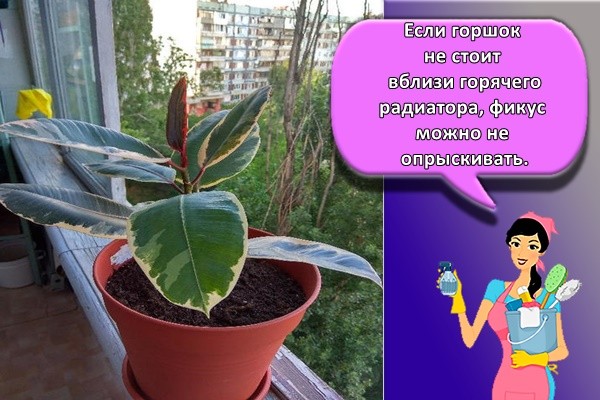
Ground requirements
The best choice is a ready-made potting soil mixture for ficuses. You can prepare the land for planting yourself - a mixture of sand, humus, peat, nutrient soil. For mature, heavy shrubs, the soil should be denser.
Watering and spraying mode
Ficus does not like excess moisture - watering is carried out when the earth in the pot has dried out to the middle of the container.
Reference: watered with settled water no more than once a week, when the growing season freezes - once every 10-14 days.
Features of the content in the winter
The dormant period with a slowdown in vegetation begins in October. The container with the flower is transferred to a cool room (13-18 °), watered every 10-14 days.
Top dressing and fertilization
During the growing season (April-September), the plant is fed by alternating mineral and organic fertilizers every 15-20 days.
Bloom
In most cases, it is not possible to achieve flowering of the ficus indoors, but the flower growers are not upset - the buds are not particularly decorative. Adult powerful ficuses usually bloom only in winter gardens.

Need
Why does ficus need pruning:
- to control the size - the height of the bush;
- for the development of lateral shoots, giving density to the crown;
- to stimulate the growth of leaves from the lateral buds.
If you do not prune, the ficus stretches upward, has weak branching, the lower part of the trunk loses foliage and remains bare.
Required tools
For work you will need:
- a sharp knife with a short blade (garden);
- secateurs or scissors;
- gloves and glasses.
Tools are pre-disinfected, hands are protected with gloves. Ficus juice is poisonous, can cause poisoning, allergies.
Recommended timing
Pruning begins when the ficus grows to 70-80 centimeters. The best time is spring, when the lush vegetation has not yet started. The pruned bush should grow lateral shoots over the season, that is, activate the lateral buds.
Step-by-step instruction
How to trim:
- prepare and disinfect instruments;
- the bush is shortened by cutting off the top - by 3-4 sheets, that is, up to 15 centimeters;
- thick shoots are cut at an angle of 45 °, thin ones - straight;
- cut out excess and curved side shoots, give the plant symmetry, free from thickening.

The sections are disinfected with crushed activated carbon, the ficus is removed from the bright sun.
Signs of improper watering
You will quickly notice the consequences of improper watering. With improper watering, the leaves turn yellow completely or at the edges, dry, fall off profusely. Excessive and insufficient watering is equally harmful to the plant.
What happens if there is a lack of moisture?
If you notice that young leaves are small, do not have time to develop and immediately fall off, the old ones begin to turn yellow completely, and the growth of new shoots stops, then it is necessary to increase the frequency of watering. These are clear signs of water scarcity. The plant becomes vulnerable to diseases and parasites. If it is not winter, you may need to increase the feeding to restore the vitality of the ficus.
In case you missed a few waterings and the soil becomes excessively dry, immerse the pot in a container of water and wait 10-15 minutes until air bubbles stop appearing on the surface of the water. Check the soil moisture in the pot, let the moisture drain.
What will happen in case of excess?

- If ficus leaves fall off regularly, especially the lower leaves, but in small quantities, this means that there is more moisture than little. Take care to reduce the intensity of watering.
- Yellowing of the edges of the leaves also indicates over-watering.
- Another sign is rot. A powdery white bloom becomes visible on the roots near the trunk. To stop putrefactive processes it is necessary to loosen the soil and reduce watering.
If the plant is flooded, it is necessary to transplant it into disinfected soil. The surface of the soil can be sprinkled with crushed activated carbon. Treat the roots with a weak solution of potassium permanganate. Cut off damaged leaves.
With a very strong bay, the plant can not be watered for 1-2 weeks, limited to spraying the leaves.
Thanks to this article, you were able to make sure that ficus trees are really unpretentious to care for. There are several nuances of caring for different species that need to be considered. The main rule of watering is simple - it is not to flood in winter and not to dry out in summer. Subject to the easy recommendations of watering, feeding, providing the plant with sufficient heat and lighting, the ficus will delight you all year round.
Next
Watering Water treatments and phalaenopsis. How to properly water an orchid?
Temperature
Indoor ficus is a thermophilic plant, but it does not tolerate heat above +30 degrees. And the optimal temperature for him is +25 degrees. In winter, when the plant has a dormant period, it is advisable to create cooler conditions for it. During this period, it is necessary that the temperature in the room is maintained from +17 to +20 degrees. So the plant will quickly go into hibernation and gain strength until the next season.
But it should be borne in mind that a temperature of +12 degrees is critical for a flower, and for variegated varieties, a temperature of +15 degrees is deadly. Therefore, make sure that the thermometer does not drop to these marks.
At any time of the year, it is necessary to provide the plant with an influx of fresh air. But keep in mind that the ficus categorically does not tolerate sudden changes in temperature and drafts. Therefore, during airing, it is advisable to take the flower to another room. Also, keep it away from air conditioners or heaters.
How to plant ficuses from one pot correctly?
Sometimes, to create a lush crown, several plants are planted in one container. When the roots grow strongly and emerge from the drainage hole, it is time to replant the plants. Can a ficus bush be divided? Yes, you can, for this they proceed as follows:
- Prepare potting mix yourself or buy at the store.
- They stock up new containers, their number depends on how many copies you decide to keep.
- The pot with plants is watered abundantly two days before transplanting.
- The container is placed on its side and a knife is drawn along the edges of the pot to separate the earth.
- Carefully take out the bush and place the earthen lump in a large container with warm water to open it.
- After a while, they carefully clean off the ground from the roots. If this cannot be done, a warm shower is sometimes used to wash off the soil.
- After cleaning, one plant is separated from another and planted in new pots in moistened soil.

After transplantation, they are put in a permanent place, watering is carried out in two days, and regular spraying is carried out.
When and how to transplant into another pot
It is best to do a Benjamin ficus transplant at home in March or April. Young specimens need a transplant every year, and adults - once every three to four years. In between, remove the top layer of the substrate from the pot and replace it with fresh.
Transplant your ficus as follows. Remove the flower from the old pot with a lump of soil and transfer it to the center of the new pot, where a layer of drainage and a layer of new substrate have already been laid. Cover the voids between the plant and the sides of the pot with earth, shaking the pot lightly. If the room is hot, lightly water the transplanted ficus and spray its crown with a fine spray bottle. If the room is cool, then it is better not to water the transplanted plant for a couple of days.
Young ficus benjamin bushes should be checked frequently for rapid root growth. To do this, turn the pot over and look at its bottom. The roots may already be peeking out of the drainage holes. If so, rejoice, you've got a fast growing specimen. Without waiting for next spring, you will have to transplant it into a new, slightly larger pot.
What kind of pot is needed

Choose a clay or ceramic pot for Benjamin's ficus. The new pot should not be too bulky, only slightly larger than the old one. Then the root system of the flower will quickly cope with the development of the entire volume of the new soil, and the flower will more easily take root in a new place.
Let's immediately pay attention to the size of the pot for creating a bonsai from ficus - it should be wide and shallow
Suitable soil

The natural habitat of Benjamin's ficus is the humid tropics with their characteristic moisture-absorbing nutrient soil. For indoor cultivation, you need to buy or prepare the substrate yourself, similar to its natural composition. For Benjamin's ficus, purchased land for ornamental deciduous plants is suitable. You can use the soil for Mulberry plants or for Palm trees. Note that ficuses are not very picky about the composition of the soil.
It is only important that it is nutritious, breathable and has neutral acidity. Self-prepared soil should be like this: a mixture of peat, garden soil and sand in equal proportions
You can add a little wood ash to eliminate acidity in the soil. Adult specimens require a denser substrate, so turf and humus should be added to this soil composition.
How to choose a pot and soil
Try to choose a ceramic or clay flowerpot. Ficus Benjamin will take root much easier if the new pot is not too large. The tub should be larger than the previous one by only a couple of centimeters - this way the root system will get used to it much faster.
The natural habitat of Benjamin's ficus is the tropics with moist soil. So, when growing it at home, you will need to prepare the appropriate soil.
You can stock up on commercial soil made for ornamental deciduous plants. For example, soil is ideal for palms and mulberry flowers. Ficus Benjamin, which is very good, is not at all picky about the composition of the soil
Only one thing is important - it must be breathable, nourishing and have neutral acidity.
If you decide to prepare the soil yourself, mix the garden soil, sand and peat in equal proportions. Optionally add some wood ash to the mixture to neutralize the acidity of the soil. Adult ficuses need a denser substrate, so humus and sod soil should be added to it.
Don't forget to add a drainage layer with pieces of charcoal to the bottom of the pot.

